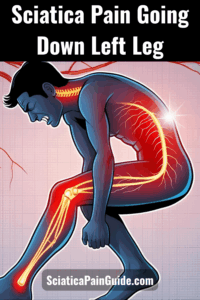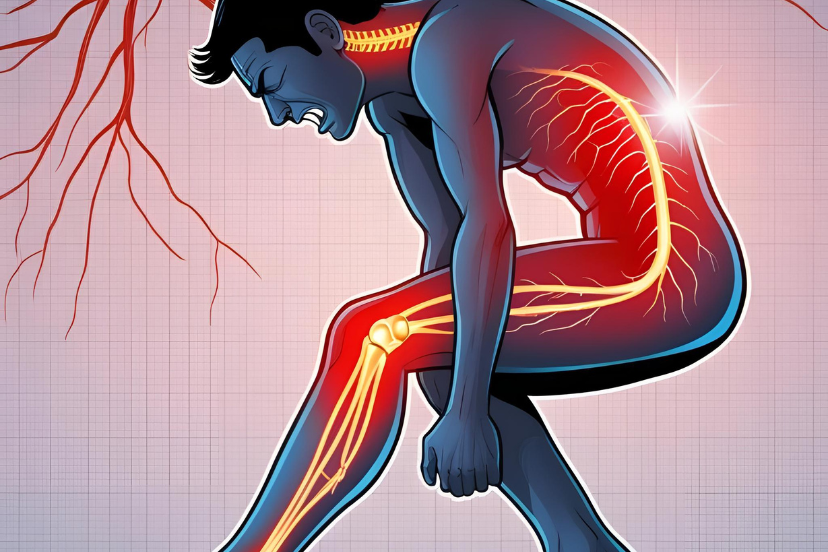Sciatica Pain Down the Left Leg: Causes, Treatments, and Quick Relief
If you’re feeling persistent or shooting pain running down your left leg, you’re not alone. Sciatica pain often affects one side of the body, and when it targets the left leg, it can disrupt walking, sitting, sleeping, and even your mood. But is left-leg pain different from right-leg sciatica? What causes one-sided symptoms, and how can you treat sciatica pain going down left leg fast?
In this guide, we’ll explore why sciatica pain going down the left leg happens, what it means, and how you can relieve it at home or with medical care.
🚻 Left Leg vs. Right Leg: Does It Matter?
One of the most common questions sciatica sufferers ask is, “Why is the pain only on my left side?”
The sciatic nerve is the longest nerve in the body, running from the lower spine down both legs. Sciatica usually affects only one leg at a time because of how nerve roots exit the spinal column and interact with nearby muscles and discs.
Key points:
-
Whether it’s the left or right leg, the underlying cause is usually similar: pressure or irritation on the nerve root in the lower back.
-
The side affected may depend on factors like posture, injury, disc herniation, or even how you sleep or sit.
✅ Good news: The treatment approach for left-sided sciatica is virtually the same as for right-sided pain, though knowing which side is affected can help tailor certain stretches and ergonomics.
Sciatica Pain Going Down Left Leg
🧠 Common Causes of One-Sided Sciatica
Pain radiating down the left leg often starts in the lower back or buttock. The most common reasons include:
1. Herniated Disc (Left Side)
When the soft center of a spinal disc pushes out and compresses the nerve root, it often causes sharp, shooting pain down one leg, depending on where the disc is bulging.
2. Piriformis Syndrome
The piriformis muscle, located deep in the buttock, can become tight or inflamed and compress the sciatic nerve, often on just one side.
3. Spinal Stenosis
This narrowing of the spinal canal can pinch nerve roots on one side, especially if the left side is more compressed.
4. Pelvic Misalignment or Uneven Hips
If your pelvis tilts more to one side, it can lead to muscular imbalances and sciatic nerve irritation on that side.
5. Injury or Inflammation
A fall, lifting injury, or strain can inflame tissues near the nerve root, often resulting in left- or right-leg pain.
🏡 At-Home Remedies for Left-Sided Sciatica Pain
The majority of sciatica cases can be managed at home, especially in the early stages. Here are some effective methods:
✅ 1. Targeted Stretching
Stretching the lower back, hips, and hamstrings can reduce nerve pressure.
Top left-leg relief stretches:
-
Knee-to-chest stretch (left leg)
-
Figure 4 piriformis stretch (left side)
-
Child’s Pose
✅ 2. Cold & Heat Therapy
-
Cold reduces inflammation (first 48 hours).
-
Heat relaxes tight muscles and improves blood flow (after 2–3 days).
Apply for 15–20 minutes, a few times daily.
✅ 3. Anti-Inflammatory Diet
Eating more omega-3s, leafy greens, berries, and avoiding processed food can reduce systemic inflammation.
✅ 4. Over-the-Counter Relief
Nonsteroidal anti-inflammatory drugs (NSAIDs) like ibuprofen can ease pain in the short term. Always follow dosing guidelines.
✅ 5. Posture Adjustments
Sitting with poor posture—especially leaning to one side—can worsen left-sided pain. Use a lumbar roll, sit evenly, and avoid slouching.
🩺 When to See a Specialist
While many people recover from sciatica within a few weeks, persistent or worsening symptoms should be checked out.
🚩 See a doctor if:
-
Pain down your left leg lasts more than 2–4 weeks
-
You experience numbness, tingling, or weakness
-
Pain worsens with time or spreads
-
You have trouble standing, walking, or balancing
-
You experience bladder or bowel issues (seek emergency care)
👨⚕️ Common treatments specialists may recommend:
-
Physical therapy: Tailored stretching, strengthening, and posture correction
-
Corticosteroid injections: For inflammation near the nerve root
-
Chiropractic care: Can help with spinal alignment and nerve compression
-
Surgery (rare): Only if conservative methods fail and pain is severe or disabling
✅ Preventative Care Tips to Avoid Left-Side Flare-Ups
Even after the pain improves, preventing recurrence is key. Here are habits to protect your spine and nerve health:
1. Strengthen Your Core
A strong core supports your spine. Try planks, bridges, or Pilates-based exercises.
2. Use Ergonomic Seating
Choose chairs with lumbar support, adjust your desk height, and avoid leaning to the left.
3. Switch Sides When Sleeping
If you always sleep on your left, try alternating or using a pillow between your knees to reduce hip rotation.
4. Lift Properly
Always bend at the knees—not the waist—and keep items close to your body.
5. Move Regularly
Avoid long periods of sitting or standing. Take stretch breaks every 30–60 minutes.
❓ FAQs About Sciatica Pain Going Down Left Leg
1. Why does my sciatica only affect my left leg?
Sciatica usually affects one leg due to nerve root compression on that side, often from a herniated disc, piriformis syndrome, or spinal misalignment.
2. Is left-leg sciatica more serious than right-leg sciatica?
Not necessarily. The side affected doesn’t typically impact severity. However, symptoms like numbness, weakness, or loss of function should always be taken seriously.
3. How long does left-sided sciatica pain last?
With at-home care, mild cases often improve within a few weeks. Chronic or severe cases may last longer and require professional treatment.
4. What sleeping position is best for left-leg sciatica?
Try sleeping on your right side with a pillow between your knees, or on your back with a pillow under your knees to ease pressure on the left sciatic nerve.
5. Can I walk if I have sciatica in my left leg?
Yes—gentle walking can actually help relieve pain. Avoid hills, uneven ground, or limping. If walking worsens symptoms, consult a specialist.
🧠 Final Thoughts
Sciatica pain going down left leg can feel frustrating and disruptive, but in many cases, it can be managed and even relieved at home. Understanding the root cause—whether it’s muscular, disc-related, or postural—can help you find the most effective relief strategy. Combine gentle stretching, posture correction, and ergonomic support for everyday comfort. And don’t hesitate to see a professional if symptoms persist or worsen. With the right approach, most people can recover without surgery and regain pain-free movement.
Disclaimer
Please note that this article should not replace professional medical advice. Consult a healthcare professional for an accurate diagnosis and tailored treatment plan.
👉 Next Reads:





